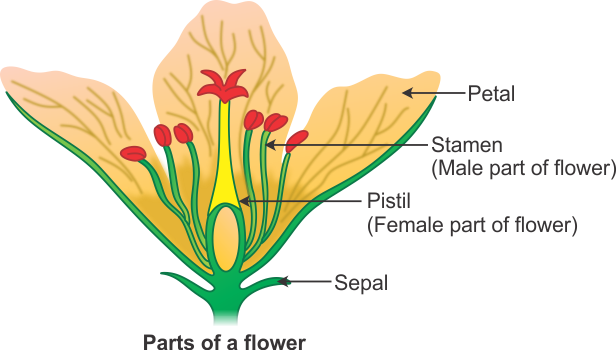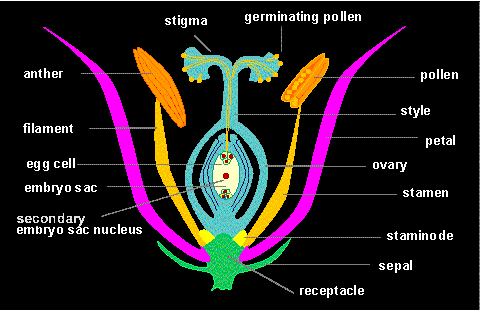39 flower diagram with labels and functions
en.wikipedia.org › wiki › Jungian_cognitive_functionsJungian cognitive functions - Wikipedia Cognitive functions, also referred to as psychological functions, as described by Carl Jung in his book Psychological Types, are particular mental processes within a person's psyche that are present regardless of common circumstance. This is a concept that serves as one of the foundations for his theory on personality type. Parts Of A Flower Identified & Explained: Diagram & Photos Its function is to protect the inner parts of the flower during the bud stage. Petal Working inwards, the next whorl after the sepals / calyx consists of the flower's petals. The main function of petals is to attract pollinators - animals that transfer pollen from flower to flower. For this reason, a flower's petals are often brightly-colored.
› type › science-diagramsScience A-Z Science Diagrams - Visual Teaching Tools Science Diagrams from Science A-Z provide colorful, full-page models of important, sometimes complex science concepts. Science Diagrams, available in both printable and projectable formats, serve as instructional tools that help students read and interpret visual devices, an important skill in STEM fields.
Flower diagram with labels and functions
Parts of a Typical Flower (With Diagram) - Biology Discussion A typical angiosperm flower has following parts: 1. Bract (= Hypsophyll): It is a leaf like structure in whose axil a flower often develops. 2. Pedicel: It is the stalk of the flower which may be short, long or even absent. 3. Bracteoles: Flower Structure and Function - World of Flowering Plants Flowers are the reproductive structures of a flowering plant. They are the primary structures used in grouping plant families. Function Reproduction, beginning with pollination and fertilization. Advertisement and rewards to lure a pollinator. Horticultural uses Aesthetic qualities Cut flowers and potted blooming plants Edible flowers and herbs Biology Of Plants - Parts Of Plants, Diagram And Functions Thus, we see how different parts of a plant help in the growth and development of a plant. All the plant parts are beneficial and work in coordination with each other. For more information on different parts of plants, diagrams and their functions, keep visiting the BYJU'S website or download BYJU'S app for further reference.
Flower diagram with labels and functions. Diagram quiz on Flower Parts The part labeled A is the outermost whorl of the flower. It is the. 4. Stamen is the male reproductive part of the flower (C). Each stamen consists of two parts, labeled E and F in the diagram. It is the. 5. The region labeled A and B are called the vegetative whorls of a flower. The whorls are. Diagram of the Parts of a Flower | Sciencing Examine a flower diagram, and you'll see that flowers consist of several parts. All these flower parts each have a specific function that allows the flower to bloom and then eventually become fruit or seed. Petal Petals are the pretty part of the flower that gives it its shape and form. Petals come in a wide variety of colors. These may include: A Labeled Diagram of the Plant Cell and Functions of its ... Its functions include, isolating materials harmful to the cell, maintaining turgor within the cell and exporting unwanted materials away from the cell. Function: Regulates internal environment. You can save and print this diagram of the plant cell. It will help you with your revision. That's about how the organelles in a cell function. PDF Parts of a Flower - University of Georgia Petals can be all colors, shapes, and smells which serve to attract pollinators. Procedure: 1. Divide the class into small groups. Each group has a plate or cup with three or more different flowers. 2. Learners begin by simply looking at the flowers and completing the I Observesection on their worksheet. See attached. 3.
Parts of Flower and Plant (Pistil, Sepal, Stamen and More ... Parts of a Flower (Diagram of Flower Anatomy With Labels) Pistil (The Female Part of the Flower) The pistil functions as the female reproductive part of the flower that comprises of the stigma, style, and ovary. Sometimes the term carpel is used in place of pistil. In some cases, a carpel and pistil are one and the same thing. Flowering Plant Diagram Labelling Activity (Teacher-Made) The resource features a labeled diagram for both a flower and a plant, and two worksheets with blanks for your children to fill out. More Flower Resources Available to Download There are lots of other flower resources that are available to download and use in your lesson plan, such as this Parts of a Flower Word Cards set which can be used to ... Structure of Flower (With Diagrams) | Botany The flower consists of an axis, also known as receptacle and lateral appendages. The appendages are known as floral parts or floral organs. They are sterile and reproductive. The sepals and petals which constitute the calyx and corolla respectively are the sterile parts. Types of Plant Cell- Definition, Structure, Functions ... Definition of a plant cell. Plant cells are multicellular eukaryotic cells that make up a plant (a group of eukaryotes belonging to the Plantae kingdom, with the ability to synthesis their own food using water, Sunlight, and CO 2).Being eukaryotic cells, they have a defined nucleus with specialized structural organelles that enable them to function in an orderly manner.
FREE! - Flower Diagram Labelling Worksheets | Resources ... These wonderful Flower Diagram Labelling Worksheets are perfect for teaching Primary Stage children about plant life cycles in your Science classes. The resource features two sets of worksheets and answer sheets. Learners are asked to label the different parts of the plant diagram on each of the sheets. Parts of Flower Diagram: Structure of Flower, Functions ... The flower is the reproductive part of the plant. They are found in flowering plants. The main function of flowers is to reproduce by the process of pollination. There are two types of pollination i.e., self-pollination and cross-pollination. Self-pollination occurs when pollen from the anther is deposited in the stigma of the same flower. › help › deeplearningTrain Generative Adversarial Network (GAN) - MATLAB & Simulink Nov 19, 2015 · Define Model Loss Functions. Create the function modelLoss, listed in the Model Loss Function section of the example, which takes as input the generator and discriminator networks, a mini-batch of input data, an array of random values, and the flip factor, and returns the loss values, the gradients of the loss values with respect to the learnable parameters in the networks, the generator state ... Plant Cell Diagram Ribosome Functions : Functions and Diagram Ribosomes are organelles located inside the animal, human cell, and plant cells. In prokaryotic cells, the ribosomes often occur freely in the cytoplasm. This basic structure of a plant cell is shown below - the same plant cell, as viewed with the light microscope, and with the transmission electron microscope.
study.com › academy › lessonStructure of Leaves: The Epidermis, Palisade and Spongy Layers Aug 18, 2021 · The Structure of Leaves. Leaves are vital to the survival of plants. They help plants in a variety of ways, including producing food and oxygen through photosynthesis, balancing water loss ...
Parts of Flower (With Diagram) & Functions of Floral ... (1) The function of corolla is to attract insects i.e. the function of flag apparatus. (2) In some cases the bases of petals act as secreting of nectar owing to the presence of glands. (3) Secondary function of corolla is protection of the essential members. ANDROECIUM
PDF Parts of a Flower Diagram Parts of a Flower Diagram . The flower is the structure the plant uses for reproduction. The sepals protect the flower before it opens. The petals attract pollinators. The anthers of the stamens (male) produce pollen. The ovules of the pistil (female) produce eggs. Pollination is the movement of pollen from the male to the female.
open.lib.umn.edu › publicspeaking › chapter15.1 Functions of Presentation Aids – Stand up, Speak out Figure 15.2 “Model of Communication” is another example of a diagram that maps out the process of human communication. In this image you clearly have a speaker and an audience (albeit slightly abstract), with the labels of source, channel, message, receivers, and feedback to illustrate the basic linear model of human communication.

Animal Cell Diagram Without Labels - Animal Cell Diagram Numbered , Transparent Cartoon, Free ...
Label Flower Anatomy Printout - EnchantedLearning.com Label Me! Printouts. Read the definitions then label the diagram below. anther - the anther is the tip of a flower's stamen ( the male reproductive organs of the plant) - it contains the pollen. filament - the filament is the part of the flower that holds the anther (and part of the stamen, the male reproductive organs of the plant).
quizlet.com › 568033559 › botany-exam-1-chs-1/2/3-4Botany Exam 1 Chs. 1, 2, 3, 4, 5, 6, 7, 12, and 16 Quizzes Mitosis, or the division of a mother cell's nucleus into two identical daughter nuclei, is typically divided into four phases. Match each of the labels to identify what events take place during each phase of mitosis. 1. Prophase 2. Metaphase 3. Anaphase 4. Telophase A) Chromosomes are aligned at the equator of the cell and the spindle is fully ...
How to draw and label a flower 🌷step by step tutorial ... A beautiful drawing of a flower. And it will teach you how to draw a flower very easily. Watch the video and please be kind enough to thumbs up to my videos....
Parts of a Flower and Their Functions (With Diagram ... The four main parts of a flower are the petals, sepals, stamen, and carpel (sometimes known as a pistil). If a flower has all four of these key parts, it is considered to be a complete flower. If any one of these elements is missing, it is an incomplete flower. Complete Rose Hibiscus Tulip Incomplete Holly Corn Squash Grasses Perfect vs. Imperfect




Post a Comment for "39 flower diagram with labels and functions"